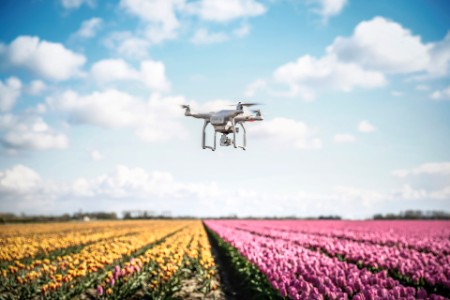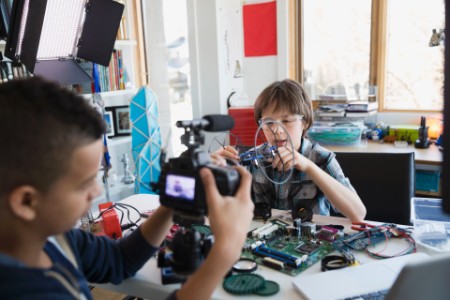
Chapter 1
Using technology creatively
Right now, businesses should focus on improving current operations – but this is only the start.
Technology is most often used to improve efficiency – mechanization and automation that can mimic human behavior to carry out repetitive, high-volume tasks. This can free up our time to focus on higher level, more valuable work – like research and development or strategic planning.
These efficiency-boosting technologies are fantastic for eliminating the need for human engagement in time-consuming back-office tasks or physical heavy lifting – enabling humans to focus more on the intellectual heavy lifting. After all, who has time to come up with new ideas if they’ve got deadlines to hit and spreadsheets to fill out?
The time saved can also create new opportunities for human engagement – getting back to being human by engaging in human-to-human relationship building and collaborative activities and projects. These kinds of interactions not only help improve organizational culture, they also enable those collaborative light-bulb moments that can lead to innovative ideas which are so often sparked by discussion.
From automation to augmentation
Key to maximizing this potential is the creative combination of AI software with other technologies, augmenting their capabilities to create new, better ways of working – and turn emerging technology into a competitive advantage.
The impact to business innovation and the transformative effect of combining emerging technologies could be far more profound than that of a single technology alone. After all, historically, most technological advances aren’t derived from one-off moments of genius, but are iterative – combining existing ideas in new ways to optimize and improve on what’s come before. Even AI itself is an example of this – the result of humans creatively combining centuries of mathematical research with decades of computing experimentation.
We call this the “combinatorial effect” of emerging technologies (pdf).
Related article
Reimagining our future working world
Right now, companies that are combining technologies like this can gain competitive advantages over more traditional rivals.
To take one example, a drone on its own is little more than a fancy radio-controlled helicopter – a toy. A drone with a camera is a surveillance tool. A drone with a camera, depth-sensors, a robotic arm, and AI is an autonomous tool that can radically change how we use warehouse space or deliver goods to customers by finding more efficient transport routes. Meanwhile, more traditional companies are still using slower, less efficient human-driven fork-lift trucks.
The next ten years will see an explosion of innovation as smart technologies mature and ever more businesses use them in combination with existing and emerging technologies to create radical new approaches to doing business and meet the ever-changing needs of their customers.
But remember this isn’t about the technology itself, no matter how creatively it’s combined. The pace of technological change will continue to accelerate – no one piece of technology will be enough to give a lasting competitive advantage in such an environment.
The truly successful businesses will be the ones that realize their transformation isn’t a one-off change to adopt the latest technological tools, but an ongoing process – with the needs of people placed firmly as the focal point of innovative efforts, not the capabilities of the currently available tools.
Looking to 2030 and beyond, the impact of such human-focused innovation could radically change how the world works. The number of possible permutations is vast – and when AI enables these new combinatorial creations to continuously self-optimize, they should get continually more impactful.
It’s time for us to reframe our relationship with technology, reimagining how to use technologies to meet real human needs, enable new ways of working, and power human enterprise. With the right approach, people can be both the drivers and beneficiaries of technological change, unlocking new paths to value and human engagement, helping us reinvent our organizations to be ready for what’s next, and fully realizing human potential.
Related article

Chapter 2
Using technology to enable more effective creative choices
By reimagining what comes beyond, the combination of AI and human intelligence can unleash a new era of creative decision-making.
The real promise of AI is more than merely freeing up our time to think, or to increase efficiency. It isn’t just about augmenting and improving other technologies – it could even augment and improve human intelligence, by helping us make better choices.
At its most basic level, AI simulates aspects of human intelligence – like pattern recognition, data analysis, and problem solving.
But while we humans can spot patterns naturally, our human biases and assumptions can get in the way. And while there have been issues with AI bias, these have mostly derived from flaws in the original – human – inputs. As we get better at creating AI, these kinds of input errors should increasingly get resolved.
As AI continues to improve, it will be able to take a less human approach to analysis and problem-solving – spotting patterns and solutions that differ from those of its human creators.
The result will be a whole new way of looking at the world. By combining human and AI understanding and interpretation, we can find whole new ways of approaching challenges, developing ideas, and driving growth.
This means that, rather than having to begin with a blank canvas, we can use AI to direct our creative judgement and decision-making processes – to suggest routes for innovation that are more likely to be successful, based on the available data.
Related article
Reinventing the creative process
In a world with more data than ever, the human mind is not naturally equipped to spot correlations across thousands of data points. But when human creativity is combined with the enormous computation power of AI techniques, we could push back the frontiers of our understanding of the world around us.
Rather than just being a faster way to analyze information, AI can become a stimulus for more creative thinking about how to use data by suggesting solutions humans may never even have considered.
Even now, smart assistants with conversational interfaces are already starting to be used to help enhance real-time decision-making processes, helping less experienced workers tap into the pooled expertise of an entire industry, suggesting better approaches to solving engineering problems.
Over the next decade, these AI helpers will increasingly start to work with more complex tasks – enabling humans to innovate by focusing on picking the best solution, not just identifying the options, or scenario modeling to help humans decide on the best options based on predictive analytics.
Beyond this horizon, the potential is for AI to become truly symbiotic with human intelligence: an increasingly essential tool for understanding the world – and devising fresh ways to improve it.
Creativity may be a uniquely human trait – but just as AI can improve the efficiency of other systems and processes, so too can it optimize the creative process.
We think about AI as software that emulates human-like cognition. It’s really just math at an enormous scale, and can be applied to an almost infinite number of use cases across every sector.

Chapter 3
How to use technology to create fresh growth
Three steps to reimagine your business and successfully navigate the Transformative Age.
It’s one thing to create a technology, but it’s another to use it to transform how a business operates.
To unlock AI’s true potential and unleash human creativity, businesses should seek to shake off their preconceptions and reimagine the fundamentals of how their industry operates – and what purposes they serve for their customers.
As you reimagine what your business and industry could look like in the next five to ten years, you should also start thinking how you can reshape your operations to make your vision as effective as possible:
- Use technology to do the mundane, freeing up humans to focus on the higher-level creative thinking and strategic decision-making that add true long-term value.
- Combine technologies to create better ways of working.
- Focus on finding ways of deploying AI not just to replace humans, but to guide their creative choices.
A successful strategy for driving long-term value and growth will never come solely from upgrading your tools – it’s from ensuring your strategies and processes meet the needs of your human customers and employees. Even the most cutting-edge technology alone will never be a lasting solution – just a way of enabling better ways of meeting those needs.
As you think about the challenges you face now, look to what’s next, and start to imagine what could come beyond, it will be the combination of human and AI that will unleash the full potential of organizations and society at large – by helping better identify human needs and ways to meet them.
One thing is certain: as customer expectations continue to shift, businesses will have to be ever more creative in meeting them. That’s one need that will never go away – and AI may well be a key tool that can help enable a more effective creative response. Only with the strategic combination of human understanding and technology empowering human enterprise will you be able to create a truly effective, adaptive, creative organization and succeed in solving the challenges to come.
Related article
Summary
Rather than be worried about the rise of AI, businesses should embrace the opportunity technology brings to unleash a new wave of human creativity and power human enterprise. It can free up time for innovation, provide new combinations of technologies to enable better ways of working, and help guide us on the path towards even more effective creative ideas.

